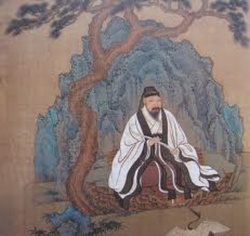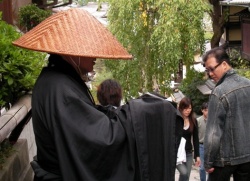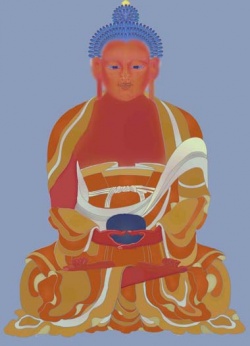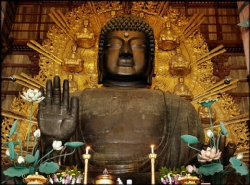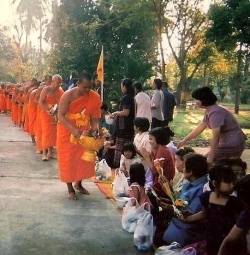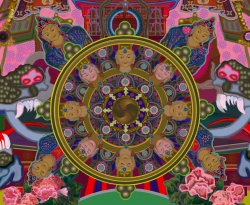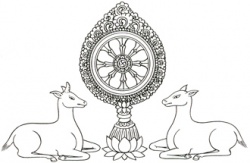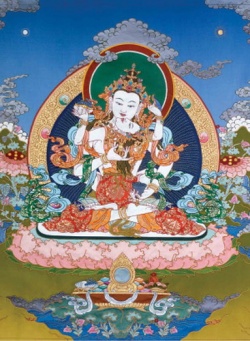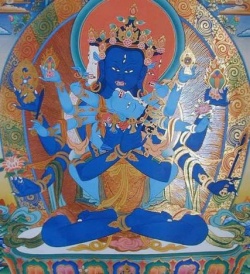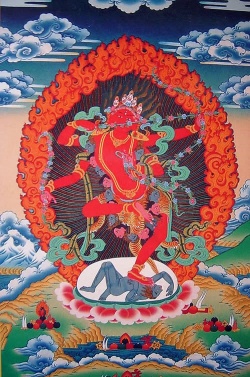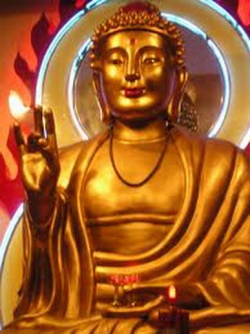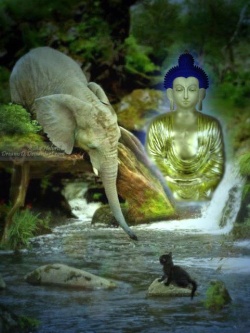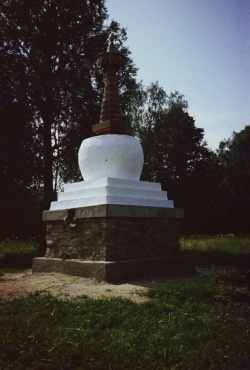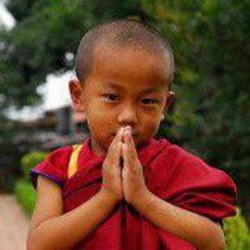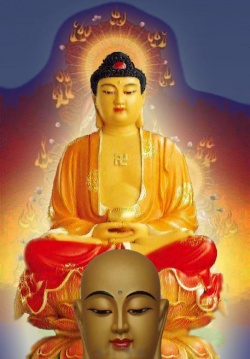Difference between revisions of "Use Your Imagination"
(Created page with " From Ven. Thrangu Rinpoche's site, with permission, comes this extract from the newsletter of January, 2001 containing extracts from Namo Buddha Publications Creati...") |
|||
| Line 1: | Line 1: | ||
| + | <nomobile>{{DisplayImages|1690|1474|1225|1166|759|3797|3502|1437|3738|3370|3151|791|1249|1126|1419|1594|3192|171|3562|4059|3439|2733|940|4037|3613}}</nomobile> | ||
| − | + | From Ven. [[Thrangu Rinpoche's]] site, with permission, comes this extract from the newsletter of January, 2001 containing extracts from [[Namo Buddha]] Publications Creation and Completion. Text is by the first [[Jamgon Kongtrul]], comments by [[Khenpo Thrangu]] (Texas in 1992) with [[Sarah]] Harding's translation. | |
| − | From Ven. [[Thrangu Rinpoche's]] site, with permission, comes this extract from the newsletter of January, 2001 containing extracts from [[Namo Buddha]] Publications Creation and Completion. Text is by the first [[Jamgon Kongtrul]], comments by [[Khenpo | ||
The spacing, capitalization and so on have sometimes been edited for ease in reading on-screen. | The spacing, capitalization and so on have sometimes been edited for ease in reading on-screen. | ||
| Line 17: | Line 17: | ||
[[Essentially]] the {{Wiki|structure}} and format of the [[generation stage]] practice is connected with, or corresponds to the way we are born. The [[idea]] of being born is the acquisition of a new [[body]]. New [[body]] of course does not mean your first [[body]], just your latest [[body]], your most recently acquired [[body]]. | [[Essentially]] the {{Wiki|structure}} and format of the [[generation stage]] practice is connected with, or corresponds to the way we are born. The [[idea]] of being born is the acquisition of a new [[body]]. New [[body]] of course does not mean your first [[body]], just your latest [[body]], your most recently acquired [[body]]. | ||
| − | There are four different ways that [[sentient beings]] can be born. The first is [[womb birth]], where as in the case of [[humans]] and other {{Wiki|mammals}} you are born from the [[womb]] of your mother. The second, which is very similar, is [[egg birth]], where you are hatched from an egg that has issued forth from the [[womb]], as is the case with birds, {{Wiki|reptiles}} and so on. Those two types are fairly coarse in manner of [[birth]]. Then there is one that is a little more {{Wiki|subtle}}, and although this is often presented as a separate type of [[birth]] (the way that [[beings]] who are not born from a [[womb]] or from eggs are born), it can also be understood as another aspect of either [[womb]] or egg generation, which is [[birth]] from heat and [[moisture]]. | + | There are four different ways that [[sentient beings]] can be born. The first is [[womb birth]], where as in the case of [[humans]] and other {{Wiki|mammals}} you are born from the [[womb]] of your mother. The second, which is very similar, is [[egg birth]], where you are hatched from an egg that has issued forth from the [[womb]], as is the case with birds, {{Wiki|reptiles}} and so on. |
| + | |||
| + | Those two types are fairly coarse in manner of [[birth]]. Then there is one that is a little more {{Wiki|subtle}}, and although this is often presented as a separate type of [[birth]] (the way that [[beings]] who are not born from a [[womb]] or from eggs are born), it can also be understood as another aspect of either [[womb]] or egg generation, which is [[birth]] from heat and [[moisture]]. | ||
| + | |||
| + | These first three types of [[birth]] correspond to three types of [[generation stage]] [[visualization]] that are principally designed to {{Wiki|purify}} the [[Wikipedia:Habit (psychology)|habit]] of these types of [[birth]]. | ||
| − | + | [[Womb birth]] is [[purified]] by the style of generation called "five-fold [[manifest]] [[awakening]]," | |
| + | [[egg birth]] by that which is called the "[[four vajras]]," | ||
| + | [[birth]] from heat and [[moisture]] by that which is called the "three procedures" or "three [[rituals]]." | ||
| − | The fourth type of [[birth]] is the way in which [[beings]] in certain [[realms]] who have particularly [[subtle bodies]] appear. It is an instantaneous [[birth]] occurring in the absence of [[womb]], egg or even heat and [[moisture]] as [[conditions]] for [[birth | + | The fourth type of [[birth]] is the way in which [[beings]] in certain [[realms]] who have particularly [[subtle bodies]] appear. It is an instantaneous [[birth]] occurring in the absence of [[womb]], egg or even heat and [[moisture]] as [[conditions]] for [[birth]]. |
| − | In this case, in an instant of [[recollection]] you simply [[visualize]] yourself as the [[deity]] without the many preliminary steps. However, although these four types of [[visualization]] (five-fold [[manifest]] [[awakening]], [[four vajras]], three procedures, and complete in an instant of [[recollection]]) do correspond individually to the [[four types of birth]], it is not the case that practicing any one of these does not {{Wiki|purify}} all four. It does. Even though there is a [[correspondence]], any one of these is sufficient in order to {{Wiki|purify}} the [[four types of birth]]. | + | This type of instantaneous [[birth]] is [[purified]] by what is called "instantaneous generation," which is also known as "generation that is complete in an instant of [[recollection]]." |
| + | |||
| + | In this case the [[meditation]] of the [[deity]] does not begin with the establishment of the [[mandala]] and the seat of the [[deity]] and then the placement of the [[seed syllable]] on the seat, its [[transformation]] into a scepter and then the scepter into the [[deity]] as is usual in other [[visualizations]]. | ||
| + | |||
| + | In this case, in an instant of [[recollection]] you simply [[visualize]] yourself as the [[deity]] without the many preliminary steps. | ||
| + | |||
| + | However, although these four types of [[visualization]] (five-fold [[manifest]] [[awakening]], [[four vajras]], three procedures, and complete in an instant of [[recollection]]) do correspond individually to the [[four types of birth]], it is not the case that practicing any one of these does not {{Wiki|purify}} all four. It does. Even though there is a [[correspondence]], any one of these is sufficient in order to {{Wiki|purify}} the [[four types of birth]]. | ||
Once one has generated the [[deity's]] [[form]] through whichever of these four procedures, then you [[visualize]] that [[deity]] with their particular position, {{Wiki|color}}, costume, ornamentation, scepters, the father, the mother, the retinue, the [[mandala]] in which they abide, and so on. From that point onwards the practice will vary quite a bit. | Once one has generated the [[deity's]] [[form]] through whichever of these four procedures, then you [[visualize]] that [[deity]] with their particular position, {{Wiki|color}}, costume, ornamentation, scepters, the father, the mother, the retinue, the [[mandala]] in which they abide, and so on. From that point onwards the practice will vary quite a bit. | ||
| Line 29: | Line 41: | ||
Depending upon what specific practice it is, there may be many other steps and stages along the way. In any case it will conclude with what is called the "withdrawal procedure." | Depending upon what specific practice it is, there may be many other steps and stages along the way. In any case it will conclude with what is called the "withdrawal procedure." | ||
| − | Withdrawal refers to the dissolution or withdrawal of the [[mandala]] into the [[clear light]] or [[emptiness]]. The entire practice can consist of a great deal of [[elaboration]] and many steps or can be very simple and concise. In any case the entire practice, starting from the very beginning of the generation of the [[deity]] and culminating with the dissolution or withdrawal of the [[deity]] and [[mandala]] into the [[clear light]], corresponds to all the events of one [[life]]. The very beginning of the generation corresponds to the entrance of the [[consciousness]] into the [[womb]], for example in the case of a [[Wikipedia:Human life|human life]]. As the practice goes on there are specific [[elements]] that correspond to the [[birth]], to all the [[experiences]] of this [[life]] and finally in the case of the withdrawal phase, to [[death]]. | + | Withdrawal refers to the dissolution or withdrawal of the [[mandala]] into the [[clear light]] or [[emptiness]]. The entire practice can consist of a great deal of [[elaboration]] and many steps or can be very simple and concise. In any case the entire practice, starting from the very beginning of the generation of the [[deity]] and culminating with the dissolution or withdrawal of the [[deity]] and [[mandala]] into the [[clear light]], corresponds to all the events of one [[life]]. |
| + | |||
| + | The very beginning of the generation corresponds to the entrance of the [[consciousness]] into the [[womb]], for example in the case of a [[Wikipedia:Human life|human life]]. As the practice goes on there are specific [[elements]] that correspond to the [[birth]], to all the [[experiences]] of this [[life]] and finally in the case of the withdrawal phase, to [[death]]. | ||
| + | |||
| + | There are many variations in the procedure, style and content of these [[generation stage]] practices. For example, in [[Tibet]] there were two periods of the introduction of [[Buddhism]]. The initial or earlier spread of the teachings in the eighth and ninth centuries led to what is called the old or [[Nyingma tradition]]. | ||
| + | |||
| + | The subsequent renewal of the [[doctrine]] with the introduction of [[new translations]] from [[India]] in the eleventh century by various [[translators]] led to what is called the new or [[Sarma tradition]]. | ||
| − | |||
The procedures and style of the practices of the [[generation stage]] in the [[Nyingma]] and [[Sarma traditions]] vary somewhat, at least in [[appearance]] and in method, but there is no difference in their effectiveness in the actual [[purification]] of the [[kleshas]]. | The procedures and style of the practices of the [[generation stage]] in the [[Nyingma]] and [[Sarma traditions]] vary somewhat, at least in [[appearance]] and in method, but there is no difference in their effectiveness in the actual [[purification]] of the [[kleshas]]. | ||
| Line 39: | Line 56: | ||
Next the text gives a description of how a [[generation stage]] practice would work. The type of [[generation stage]] practice that is used for an example, is (from the two styles of [[Sarma]] and [[Nyingma]]) basically a [[Nyingma]] model but it will give you an [[idea]] of how a [[generation stage]] procedure works. | Next the text gives a description of how a [[generation stage]] practice would work. The type of [[generation stage]] practice that is used for an example, is (from the two styles of [[Sarma]] and [[Nyingma]]) basically a [[Nyingma]] model but it will give you an [[idea]] of how a [[generation stage]] procedure works. | ||
| − | The [[characteristic]] of a [[Nyingma]] approach to [[generation stage]] is the [[cultivation]] of what are called the "[[three samadhis]]" or "three [[meditative absorptions]]." These correspond to the [[dharmakaya]], the [[sambhogakaya]] and the [[nirmanakaya]]. | + | The [[characteristic]] of a [[Nyingma]] approach to [[generation stage]] is the [[cultivation]] of what are called the "[[three samadhis]]" or "three [[meditative absorptions]]." |
| + | |||
| + | These correspond to the [[dharmakaya]], the [[sambhogakaya]] and the [[nirmanakaya]]. | ||
| + | |||
The first [[samadhi]] connected with the [[dharmakaya]] is called the "[[samadhi]] of thatness or [[suchness]]." It [[essentially]] consists of [[meditation on emptiness]]. With regard to what it purifies, it corresponds to one's [[death]] in the preceding [[life]], to the point at which the [[appearances]] of the preceding [[life]] have vanished and there is an [[experience]] of nothing whatsoever which is like [[emptiness]]. | The first [[samadhi]] connected with the [[dharmakaya]] is called the "[[samadhi]] of thatness or [[suchness]]." It [[essentially]] consists of [[meditation on emptiness]]. With regard to what it purifies, it corresponds to one's [[death]] in the preceding [[life]], to the point at which the [[appearances]] of the preceding [[life]] have vanished and there is an [[experience]] of nothing whatsoever which is like [[emptiness]]. | ||
| − | Following this [[meditation on emptiness]], which is the [[samadhi]] of thatness and corresponds to the [[dharmakaya]], is the [[meditation]] on the [[compassion]] that has the [[characteristics]] of being like a [[magical]] [[illusion]]. This is called the "[[samadhi]] or [[meditative absorption]] which appears everywhere." It corresponds to the [[sambhogakaya]] and it purifies the subsequent [[experience]] of the [[bardo]] (one's [[experience]] after one's previous [[death]] and before one's {{Wiki|conception}} in this [[life]].) The function of this second [[samadhi]] which corresponds to the [[sambhogakaya]] is to [[form]] a link between the [[dharmakaya]] and the coarse or full [[manifestation]] of the [[nirmanakaya]]. Therefore, it [[forms]] the basis for [a] prelude to the generation of the [[mandala]]. | + | Following this [[meditation on emptiness]], which is the [[samadhi]] of thatness and corresponds to the [[dharmakaya]], is the [[meditation]] on the [[compassion]] that has the [[characteristics]] of being like a [[magical]] [[illusion]]. |
| + | |||
| + | This is called the "[[samadhi]] or [[meditative absorption]] which appears everywhere." It corresponds to the [[sambhogakaya]] and it purifies the subsequent [[experience]] of the [[bardo]] (one's [[experience]] after one's previous [[death]] and before one's {{Wiki|conception}} in this [[life]].) | ||
| + | |||
| + | The function of this second [[samadhi]] which corresponds to the [[sambhogakaya]] is to [[form]] a link between the [[dharmakaya]] and the coarse or full [[manifestation]] of the [[nirmanakaya]]. Therefore, it [[forms]] the basis for [a] prelude to the generation of the [[mandala]]. | ||
| + | |||
| + | The third [[samadhi]], which is connected to the [[nirmanakaya]] is called the "[[samadhi]] of [[cause]]" and is the initial [[visualization]] of the [[seed syllable]] of the [[deity]]. This corresponds to the [[emergence]] of your [[consciousness]] from the [[bardo]] and its actual entrance into the [[womb]]. | ||
| + | |||
| + | Therefore, along with [[visualizing]] the [[seed-syllable]] one [[visualizes]] the seat or pedestal of the [[deity]], which will consist of either a [[lotus]] with {{Wiki|sun}} and [[moon]] discs or a [[lotus]] with either just a [[moon]] or just a {{Wiki|sun}}. | ||
| − | |||
Initially one begins the [[visualization]] by [[Wikipedia:Imagination|imagining]] this [[lotus]], {{Wiki|sun}} and [[moon]] pedestal; this corresponds to and purifies the white and red [[elements]], the sperm and ovum which come from the [[parents]] and are the [[physical]] or substantial basis for your [[physical body]]. | Initially one begins the [[visualization]] by [[Wikipedia:Imagination|imagining]] this [[lotus]], {{Wiki|sun}} and [[moon]] pedestal; this corresponds to and purifies the white and red [[elements]], the sperm and ovum which come from the [[parents]] and are the [[physical]] or substantial basis for your [[physical body]]. | ||
| Line 57: | Line 84: | ||
Having [[visualized]] yourself as the [[deity]], you [[imagine]] the three {{Wiki|syllables}} of OM, AH, HUNG in the three places of the [[deity's]] [[body]]; this purifies the [[habits]] from this [[life]] of [[body, speech and mind]]. (This procedure is [[essentially]] [[characteristic]] of the [[Nyingma school]], beginning with the [[three samadhis]] and then culminating in the [[gradual]] generation of the [[deity]] from {{Wiki|syllable}}, scepter and the entire [[body]].) | Having [[visualized]] yourself as the [[deity]], you [[imagine]] the three {{Wiki|syllables}} of OM, AH, HUNG in the three places of the [[deity's]] [[body]]; this purifies the [[habits]] from this [[life]] of [[body, speech and mind]]. (This procedure is [[essentially]] [[characteristic]] of the [[Nyingma school]], beginning with the [[three samadhis]] and then culminating in the [[gradual]] generation of the [[deity]] from {{Wiki|syllable}}, scepter and the entire [[body]].) | ||
| − | In the [[tantras]] of the [[Sarma]] or [[New Translation]] school there is often the generation of the "causal [[vajra holder]]" and "resultant [[vajra holder]]" which is a different way of [[generating the deity]]. (In the more elaborate practices of the [[New Translation]] school there tend to be two generations of the [[deity]].) First, through whatever [[gradual]] procedure the [[deity]] is generated; at that point the [[deity]] is called the causal [[vajra holder]]. This first [[form]] of the [[deity]] is generated in order to {{Wiki|purify}} the process of [[death]] of one's previous [[life]]. The causal [[vajra holder]] [[form]] of the [[deity]] which has been generated will then melt into {{Wiki|light}}, becoming a [[sphere]] of {{Wiki|light}}. | + | In the [[tantras]] of the [[Sarma]] or [[New Translation]] school there is often the generation of the "causal [[vajra holder]]" and "resultant [[vajra holder]]" which is a different way of [[generating the deity]]. (In the more elaborate practices of the [[New Translation]] school there tend to be two generations of the [[deity]].) |
| + | |||
| + | First, through whatever [[gradual]] procedure the [[deity]] is generated; at that point the [[deity]] is called the causal [[vajra holder]]. This first [[form]] of the [[deity]] is generated in order to {{Wiki|purify}} the process of [[death]] of one's previous [[life]]. The causal [[vajra holder]] [[form]] of the [[deity]] which has been generated will then melt into {{Wiki|light}}, becoming a [[sphere]] of {{Wiki|light}}. | ||
| + | |||
From that [[sphere]] of {{Wiki|light}} the [[deity]] is generated a second time. This is called the resultant [[vajra holder]]. This corresponds to and purifies the [[arising]] of the [[mental body]] in the [[bardo]] or {{Wiki|interval}} between [[lives]] as well as the entrance of that [[consciousness]] which has arisen as a [[mental body]] into the [[womb]]; the process of {{Wiki|gestation}} and [[birth]]. | From that [[sphere]] of {{Wiki|light}} the [[deity]] is generated a second time. This is called the resultant [[vajra holder]]. This corresponds to and purifies the [[arising]] of the [[mental body]] in the [[bardo]] or {{Wiki|interval}} between [[lives]] as well as the entrance of that [[consciousness]] which has arisen as a [[mental body]] into the [[womb]]; the process of {{Wiki|gestation}} and [[birth]]. | ||
In the details these practices can vary quite a bit. For example, in some practices with causal and resultant [[vajra]] holders at the time of the causal [[vajra holder]] the other [[deities]] of the [[mandala]] will be emanated from the secret [[space]] of the mother or [[consort]] of the [[principal]] [[deity]]. Then the causal [[vajra holder]], father and mother, will melt into {{Wiki|light}} and become a [[sphere]] of {{Wiki|light}}. | In the details these practices can vary quite a bit. For example, in some practices with causal and resultant [[vajra]] holders at the time of the causal [[vajra holder]] the other [[deities]] of the [[mandala]] will be emanated from the secret [[space]] of the mother or [[consort]] of the [[principal]] [[deity]]. Then the causal [[vajra holder]], father and mother, will melt into {{Wiki|light}} and become a [[sphere]] of {{Wiki|light}}. | ||
| + | |||
At that point the [[dakinis]] and other [[deities]] of the retinue who have been emanated, will request the central [[deity]], who is now in the [[form]] of a [[sphere]] of {{Wiki|light}}, to arise from [[emptiness]] for the [[benefit]] of [[beings]], in response to which that [[sphere]] of {{Wiki|light}} will turn into the resultant [[vajra holder]]. | At that point the [[dakinis]] and other [[deities]] of the retinue who have been emanated, will request the central [[deity]], who is now in the [[form]] of a [[sphere]] of {{Wiki|light}}, to arise from [[emptiness]] for the [[benefit]] of [[beings]], in response to which that [[sphere]] of {{Wiki|light}} will turn into the resultant [[vajra holder]]. | ||
| Line 67: | Line 98: | ||
Also, in some other practices rather than having the causal and resultant [[vajra holder]], the end of one's previous [[life]] is [[purified]] by [[visualizing]] the [[gradual]] dissolution of the three {{Wiki|syllables}} OM, AH, HUNG corresponding to the [[stages of death]] called [[appearance, increase and attainment]]. (In that way within the general category of the [[New Translation]] school [[generation stage]] practices, there are many variations.) | Also, in some other practices rather than having the causal and resultant [[vajra holder]], the end of one's previous [[life]] is [[purified]] by [[visualizing]] the [[gradual]] dissolution of the three {{Wiki|syllables}} OM, AH, HUNG corresponding to the [[stages of death]] called [[appearance, increase and attainment]]. (In that way within the general category of the [[New Translation]] school [[generation stage]] practices, there are many variations.) | ||
| − | Whether the practice is of the [[Nyingma]] style or of the [[Sarma]] style, once the [[deity]] has been generated completely usually you will [[visualize]] that from the [[heart]] of yourself as the [[deity]] [[rays of light]] shoot out and invite the [[wisdom]] [[beings]] or the [[jnanasattvas]] which are the actual [[deity]]. You think that these are invited and dissolve into you, at which point you rest in the [[confidence]] that the [[jnanasattvas]] have actually entered into your being. This corresponds to and purifies the {{Wiki|learning}} process you go through after [[birth]]. | + | Whether the practice is of the [[Nyingma]] style or of the [[Sarma]] style, once the [[deity]] has been generated completely usually you will [[visualize]] that from the [[heart]] of yourself as the [[deity]] [[rays of light]] shoot out and invite the [[wisdom]] [[beings]] or the [[jnanasattvas]] which are the actual [[deity]]. |
| + | |||
| + | You think that these are invited and dissolve into you, at which point you rest in the [[confidence]] that the [[jnanasattvas]] have actually entered into your being. This corresponds to and purifies the {{Wiki|learning}} process you go through after [[birth]]. | ||
| + | |||
Following that, again usually you will invite the five {{Wiki|male}} and {{Wiki|female}} [[Buddhas]] and so forth, who will bestow [[empowerment]] upon yourself as the [[deity]]. This is done in order to {{Wiki|purify}} your [[family]] inheritance, everything that you in any [[sense]] inherit from your [[parents]]. | Following that, again usually you will invite the five {{Wiki|male}} and {{Wiki|female}} [[Buddhas]] and so forth, who will bestow [[empowerment]] upon yourself as the [[deity]]. This is done in order to {{Wiki|purify}} your [[family]] inheritance, everything that you in any [[sense]] inherit from your [[parents]]. | ||
| Line 74: | Line 108: | ||
Following that comes the repetition of the [[mantra]]. The [[mantra]] repetition purifies all of your talk and [[conversation]] throughout your [[life]], especially talk connected to [[attachment]], [[aversion]] and [[bewilderment]]. | Following that comes the repetition of the [[mantra]]. The [[mantra]] repetition purifies all of your talk and [[conversation]] throughout your [[life]], especially talk connected to [[attachment]], [[aversion]] and [[bewilderment]]. | ||
| + | |||
Following that comes the withdrawal or dissolution of the [[visualization]] into [[emptiness]] and finally the re-arising of yourself as the [[deity]]. These correspond to your [[death]] at the end of this [[life]] and to your re-arising in a [[mental body]] in the [[bardo]] or {{Wiki|interval}} after [[death]]. | Following that comes the withdrawal or dissolution of the [[visualization]] into [[emptiness]] and finally the re-arising of yourself as the [[deity]]. These correspond to your [[death]] at the end of this [[life]] and to your re-arising in a [[mental body]] in the [[bardo]] or {{Wiki|interval}} after [[death]]. | ||
| Line 79: | Line 114: | ||
In that way the procedure of any one [[generation stage]] practice contains the complete [[correspondence]] to all of the events of one [[life]] cycle starting with the [[bardo]] and the entrance of the [[bardo consciousness]] into the [[womb]]; going through your whole [[life]] and ending with your [[death]], and again your entrance into the [[bardo]]. | In that way the procedure of any one [[generation stage]] practice contains the complete [[correspondence]] to all of the events of one [[life]] cycle starting with the [[bardo]] and the entrance of the [[bardo consciousness]] into the [[womb]]; going through your whole [[life]] and ending with your [[death]], and again your entrance into the [[bardo]]. | ||
| − | Invariably such practices are preceded by [[going for refuge]] and generating [[bodhichitta]] and followed by the [[dedication of merit]] and the making of [[aspirations]]. These are [[essential]] for the practice to be a [[mahayana]] practice. At the very beginning therefore, is the [[going for refuge]] and the [[generation of bodhichitta]] as your [[intention]] for the practice, making [[aspirations]] for the [[benefit]] of [[beings]] and at the end your [[dedication]] of the [[merit]] to all [[beings]]. (These are the [[principal]] practices of the [[mahayana]] and therefore are used to embrace the technique of the [[generation stage]] practice and make it a proper [[mahayana]] practice.) | + | |
| + | Invariably such practices are preceded by [[going for refuge]] and generating [[bodhichitta]] and followed by the [[dedication of merit]] and the making of [[aspirations]]. These are [[essential]] for the practice to be a [[mahayana]] practice. At the very beginning therefore, is the [[going for refuge]] and the [[generation of bodhichitta]] as your [[intention]] for the practice, making [[aspirations]] for the [[benefit]] of [[beings]] and at the end your [[dedication]] of the [[merit]] to all [[beings]]. | ||
| + | |||
| + | (These are the [[principal]] practices of the [[mahayana]] and therefore are used to embrace the technique of the [[generation stage]] practice and make it a proper [[mahayana]] practice.) | ||
| + | |||
In many [[generation stage]] practices there will be additional [[elements]], such as the [[consecration]] of the [[offerings]] and sometimes [[feast offering]]. The {{Wiki|purpose}} of the [[consecration]] of [[offerings]] and the making of feast [[offerings]] is to [[gather]] the [[two accumulations]] which are the [[accumulation of merit]] and the [[accumulation of wisdom]]. Although the text says "to [[gather]] the [[two accumulations]]," principally these lead to the [[accumulation of merit]]. | In many [[generation stage]] practices there will be additional [[elements]], such as the [[consecration]] of the [[offerings]] and sometimes [[feast offering]]. The {{Wiki|purpose}} of the [[consecration]] of [[offerings]] and the making of feast [[offerings]] is to [[gather]] the [[two accumulations]] which are the [[accumulation of merit]] and the [[accumulation of wisdom]]. Although the text says "to [[gather]] the [[two accumulations]]," principally these lead to the [[accumulation of merit]]. | ||
| Line 89: | Line 128: | ||
The fourth topic about the [[generation stage]] is the result of [[purification]]; result of the full removal of [[obscurations]] of the basis or ground of [[purification]]. When that [[sugatagarbha]] or [[buddhanature]] that is itself the ground of [[purification]] is fully revealed, when everything that obscures it is removed, that is the result. | The fourth topic about the [[generation stage]] is the result of [[purification]]; result of the full removal of [[obscurations]] of the basis or ground of [[purification]]. When that [[sugatagarbha]] or [[buddhanature]] that is itself the ground of [[purification]] is fully revealed, when everything that obscures it is removed, that is the result. | ||
| − | The view of the [[generation stage]] is that this [[Buddhanature]] itself contains all of the qualities of the [[deities]]. So when you [[visualize]] yourself as a [[deity]] you are [[visualizing]] yourself as something that is a similitude of your [[own]] [[buddhanature]], something that has the same [[characteristics]] as your [[own]] [[buddhanature]]. The [[reason]] you do this is because by doing so you familiarize yourself with [[buddhanature]] and therefore allow [[buddhanature]] to reveal itself. | + | The view of the [[generation stage]] is that this [[Buddhanature]] itself contains all of the qualities of the [[deities]]. |
| + | |||
| + | So when you [[visualize]] yourself as a [[deity]] you are [[visualizing]] yourself as something that is a similitude of your [[own]] [[buddhanature]], something that has the same [[characteristics]] as your [[own]] [[buddhanature]]. | ||
| + | |||
| + | The [[reason]] you do this is because by doing so you familiarize yourself with [[buddhanature]] and therefore allow [[buddhanature]] to reveal itself. | ||
| + | |||
It is not that through the [[generation stage]] you are creating a result. You are revealing the ground as a result. The result is that through this process of familiarization, taking the [[appearance]] of the ground as the [[path]], you come to fully reveal that ground. When everything that obscures it has been removed, then that ground fully revealed is itself the [[fruition]] or result. In other words, the result or [[fruition]] does not come from outside, it is revealed from within. | It is not that through the [[generation stage]] you are creating a result. You are revealing the ground as a result. The result is that through this process of familiarization, taking the [[appearance]] of the ground as the [[path]], you come to fully reveal that ground. When everything that obscures it has been removed, then that ground fully revealed is itself the [[fruition]] or result. In other words, the result or [[fruition]] does not come from outside, it is revealed from within. | ||
| − | The [[generation stage]] is the practice of a [[yidam]] and you do that specific [[yidam practice]] exactly as it is prescribed in the liturgy for that practice. If the liturgy is elaborate and long and prescribes an elaborate series of steps to the [[visualization]], that is what you [[visualize]]. If it is concise and prescribes that the [[deity]] is [[visualized]] complete in an instant of [[recollection]], then that is what you [[visualize]]. In either case, in the [[principal]] or main practice of a [[yidam]], the main thing is to [[visualize]] yourself as that [[deity]], as that [[yidam]]. | + | The [[generation stage]] is the practice of a [[yidam]] and you do that specific [[yidam practice]] exactly as it is prescribed in the liturgy for that practice. If the liturgy is elaborate and long and prescribes an elaborate series of steps to the [[visualization]], that is what you [[visualize]]. |
| + | |||
| + | If it is concise and prescribes that the [[deity]] is [[visualized]] complete in an instant of [[recollection]], then that is what you [[visualize]]. In either case, in the [[principal]] or main practice of a [[yidam]], the main thing is to [[visualize]] yourself as that [[deity]], as that [[yidam]]. | ||
| − | We also do other practices where the {{Wiki|emphasis}} is not on [[visualizing]] yourself as a [[deity]] but on [[visualizing]] [[deities]] external to yourself. For example, when we [[visualize]] the sources of [[refuge]] in the [[refuge]] and in [[prostration]] practice, we [[visualize]] them in front of ourselves. When we [[visualize]] [[Vajrasattva]] in the [[Vajrasattva]] [[preliminary practice]] we [[visualize]] [[Vajrasattva]] seated above our head. When we do the [[Chenrezig]] practice we commence the practice with the [[visualization]] of [[Chenrezig]] above our head. The [[reason]] why in these three types of practices the [[visualization]] is different from a [[Wikipedia:Convention (norm)|conventional]] [[generation stage]] practice of self-visualization is that these practices are designed for those who are beginning [[vajrayana practice]]. In the very beginning you cannot simply start with revealing your [[own]] inner [[wisdom]]. You cannot begin with the discovery of [[wisdom]] within yourself, which is the [[principal]] [[reason]] for self-visualization. | + | |
| + | We also do other practices where the {{Wiki|emphasis}} is not on [[visualizing]] yourself as a [[deity]] but on [[visualizing]] [[deities]] external to yourself. For example, when we [[visualize]] the sources of [[refuge]] in the [[refuge]] and in [[prostration]] practice, we [[visualize]] them in front of ourselves. | ||
| + | |||
| + | When we [[visualize]] [[Vajrasattva]] in the [[Vajrasattva]] [[preliminary practice]] we [[visualize]] [[Vajrasattva]] seated above our head. When we do the [[Chenrezig]] practice we commence the practice with the [[visualization]] of [[Chenrezig]] above our head. The [[reason]] why in these three types of practices the [[visualization]] is different from a [[Wikipedia:Convention (norm)|conventional]] [[generation stage]] practice of self-visualization is that these practices are designed for those who are beginning [[vajrayana practice]]. | ||
| + | |||
| + | |||
| + | In the very beginning you cannot simply start with revealing your [[own]] inner [[wisdom]]. You cannot begin with the discovery of [[wisdom]] within yourself, which is the [[principal]] [[reason]] for self-visualization. | ||
There is something that needs to be made dear about the [[nature]] of the [[deities]] in the [[vajrayana]] because it seems in some contexts we almost externalize them as in the [[preliminary practices]]. Primarily we view them as something internal, something that is within us. | There is something that needs to be made dear about the [[nature]] of the [[deities]] in the [[vajrayana]] because it seems in some contexts we almost externalize them as in the [[preliminary practices]]. Primarily we view them as something internal, something that is within us. | ||
| − | |||
| − | |||
| − | The [[Buddhist view]] of [[deities]] is entirely different. First of all, it is held by the [[Buddhist tradition]] that your [[happiness]] and [[suffering]] come about because of your [[own]] previous [[actions]], and that no other being can actually [[cause]] you to [[experience]] what you have not [[caused]] yourself [[karmically]]. What you [[experience]] comes about because of your [[own]] previous [[actions]] and because of your [[habits]] of [[perception]]. Ultimately {{Wiki|speaking}}, from a [[Buddhist]] point of view no [[deity]] can grant you [[siddhi]] or [[attainment]]. You receive [[attainment]] through your removal of those [[obscurations]] which otherwise obscure your innate [[wisdom]]. In the [[Buddhist tradition]] [[attainment]] is the [[revelation]] of that [[wisdom]] that is innate. Therefore in the [[Buddhist tradition]] we do not assert that [[attainment]] is actually given to you by the whim of any external being. | + | First of all a {{Wiki|distinction}} needs to be made between the use of a [[deity]] in a [[non-theistic]] [[tradition]] such as [[Buddhism]] and in a {{Wiki|theistic}} [[tradition]] such as [[Hinduism]]. In the [[Hindu]] practices which work with the [[iconography]] of [[deities]], the [[deities]] are considered to be external and [[essentially]] to have the role of being creators of the [[universe]]. |
| + | |||
| + | It is understood that these [[deities]] have the power to make you [[happy]] and to make you [[suffer]]. These [[deities]] if [[pleased]] have the power to bring you to [[liberation]]; have the power to grant you all kinds of [[attainments]]; supreme and common [[attainments]]. Therefore, the practice in such a [[tradition]] consists of praying to [[deities]] with the greatest [[faith]] and [[devotion]], making [[offerings]] to them with the [[understanding]] that if they are [[pleased]] they will grant you [[attainments]], and that if they are not [[pleased]] and become [[angry]] they can actually cast you into the [[lower realms]]. | ||
| + | |||
| + | |||
| + | The [[Buddhist view]] of [[deities]] is entirely different. First of all, it is held by the [[Buddhist tradition]] that your [[happiness]] and [[suffering]] come about because of your [[own]] previous [[actions]], and that no other being can actually [[cause]] you to [[experience]] what you have not [[caused]] yourself [[karmically]]. | ||
| + | |||
| + | What you [[experience]] comes about because of your [[own]] previous [[actions]] and because of your [[habits]] of [[perception]]. Ultimately {{Wiki|speaking}}, from a [[Buddhist]] point of view no [[deity]] can grant you [[siddhi]] or [[attainment]]. | ||
| + | |||
| + | You receive [[attainment]] through your removal of those [[obscurations]] which otherwise obscure your innate [[wisdom]]. In the [[Buddhist tradition]] [[attainment]] is the [[revelation]] of that [[wisdom]] that is innate. Therefore in the [[Buddhist tradition]] we do not assert that [[attainment]] is actually given to you by the whim of any external being. | ||
| + | |||
On the other hand, there also [[exist]] [[traditions]] that say that there is no help whatsoever from outside, that the [[path]] consists entirely of one's [[own]] internal work and that any supplication of any [[awakened]] being is meaningless. But this is not exactly the [[Buddhist view]] either, because while it is true that no [[Buddha]] can hand you or give you the result or [[fruition]] of this [[path]], they can help. | On the other hand, there also [[exist]] [[traditions]] that say that there is no help whatsoever from outside, that the [[path]] consists entirely of one's [[own]] internal work and that any supplication of any [[awakened]] being is meaningless. But this is not exactly the [[Buddhist view]] either, because while it is true that no [[Buddha]] can hand you or give you the result or [[fruition]] of this [[path]], they can help. | ||
| Line 110: | Line 170: | ||
Many things changed as a result: Maybe you had no [[confidence]] in [[Dharma]] and then came to have [[confidence]]. You had no [[devotion]] and then you came to have [[devotion]]. You came to have more [[compassion]] than you did before. Your [[meditation]] improves and so on. | Many things changed as a result: Maybe you had no [[confidence]] in [[Dharma]] and then came to have [[confidence]]. You had no [[devotion]] and then you came to have [[devotion]]. You came to have more [[compassion]] than you did before. Your [[meditation]] improves and so on. | ||
| − | |||
| − | + | Now none of these things were precisely given to you by your [[root guru]], but nevertheless something happens surrounding your relationship with the [[root guru]] and this is what we call the [[blessing]] of the [[guru]]. This is all easy to understand because it is concerned with your relationship or interaction with someone you have met, someone who is another [[human being]]. | |
| − | + | But you also supplicate [[gurus]] of the {{Wiki|past}}, [[gurus]] you have not met, [[gurus]] who are not [[visible]] to you at the {{Wiki|present}}. So supplicating them, even though they also, like your [[root guru]], cannot hand you [[attainment]] or the [[fruition]], like your [[root guru]] they can influence you. | |
| − | The third [[root]] is the [[dharmapalas]] or [[Dharma protectors]] who are the [[root]] of [[activity]]. Now the function of [[dharmapalas]] is to help you free yourself from anything that impedes your practice and [[path]]. They help to encourage your {{Wiki|exertion}}, encourage your [[devotion]]; they help you find ways to {{Wiki|purify}} your [[obscurations]] and your wrong-doing. [[Dharmapalas]] are basically [[Buddhas]] who take this type of position or role for the aid of practitioners. So while it is not the case that any external being can grant you [[supreme siddhi]], these [[three roots]] - the [[gurus]], [[yidams]] and [[dharmapalas]] - if you supplicate them, can bestow [[blessing]] and can help remove [[obstacles]] on your [[path]]. | + | |
| + | They can help you. It is not particularly that by supplicating them they are [[pleased]] and therefore decide to share their [[spiritual]] [[wealth]] with you. It is rather that the [[devotion]] you generate in your supplication of them [[causes]] this [[blessing]] simply to occur. | ||
| + | |||
| + | Therefore the [[guru]] can still grant [[blessing]] even when he or she is not {{Wiki|physically}} {{Wiki|present}} in your [[perception]]. That is the first of the [[three roots]] or three sources of [[vajrayana practice]], the [[guru]] which is the [[root]] of [[blessing]]. | ||
| + | |||
| + | |||
| + | |||
| + | The second [[root]] is the [[yidam]], the [[deity]] which is the [[root]] of [[attainment]]. [[Essentially]], [[yidams]] are the [[forms]] of the [[sambhogakaya]] that [[Buddhas]] take in order to {{Wiki|communicate}} with and train [[beings]]. | ||
| + | |||
| + | It is not the case that literally {{Wiki|speaking}} your [[yidam]] can give you or hand you supreme [[attainment]], but like [[gurus]], [[yidams]] can influence you. | ||
| + | |||
| + | They grant you their [[blessing]] in the [[sense]] that through working with a [[yidam]], a new clarity dawns in your [[meditative absorption]] and you come to gradually realize something or attain something. To be precise, we would say that in saying that [[yidams]] are the [[root]] of [[siddhi]], we do not mean that they grant it, but that they facilitate it. | ||
| + | |||
| + | |||
| + | The third [[root]] is the [[dharmapalas]] or [[Dharma protectors]] who are the [[root]] of [[activity]]. Now the function of [[dharmapalas]] is to help you free yourself from anything that impedes your practice and [[path]]. | ||
| + | |||
| + | They help to encourage your {{Wiki|exertion}}, encourage your [[devotion]]; they help you find ways to {{Wiki|purify}} your [[obscurations]] and your wrong-doing. [[Dharmapalas]] are basically [[Buddhas]] who take this type of position or role for the aid of practitioners. | ||
| + | |||
| + | So while it is not the case that any external being can grant you [[supreme siddhi]], these [[three roots]] - the [[gurus]], [[yidams]] and [[dharmapalas]] - if you supplicate them, can bestow [[blessing]] and can help remove [[obstacles]] on your [[path]]. | ||
For these [[reasons]] as you will discover when you do the intensive practice of the [[generation stage]] in [[retreat]], most [[generation stage]] practice consists of [[visualizing]] yourself as the [[deity]], because the most [[essential]] thing in our practice of the [[generation stage]] is to reveal and expand our [[own]] innate [[wisdom]]. | For these [[reasons]] as you will discover when you do the intensive practice of the [[generation stage]] in [[retreat]], most [[generation stage]] practice consists of [[visualizing]] yourself as the [[deity]], because the most [[essential]] thing in our practice of the [[generation stage]] is to reveal and expand our [[own]] innate [[wisdom]]. | ||
| − | While that is the [[principal]] practice, in the special circumstances of feast practice, particularly of self-empowerment in which you give yourself the [[empowerment]] of that specific practice upon its completion, you not only do the [[visualization]] of yourself as the [[deity]], but you also [[visualize]] the [[deity]] in front. You do so because making [[offerings]] to the [[deity]] [[visualized]] in front of you, as it is in the context of feast practice, is a great way to [[accumulate]] [[merit]]. By receiving the [[blessing]] or [[empowerment]] from the [[deity]] [[visualized]] in front of you, you will be especially confident that you actually received that [[blessing]] or received that [[empowerment]]. | + | While that is the [[principal]] practice, in the special circumstances of feast practice, particularly of self-empowerment in which you give yourself the [[empowerment]] of that specific practice upon its completion, you not only do the [[visualization]] of yourself as the [[deity]], but you also [[visualize]] the [[deity]] in front. |
| + | |||
| + | You do so because making [[offerings]] to the [[deity]] [[visualized]] in front of you, as it is in the context of feast practice, is a great way to [[accumulate]] [[merit]]. By receiving the [[blessing]] or [[empowerment]] from the [[deity]] [[visualized]] in front of you, you will be especially confident that you actually received that [[blessing]] or received that [[empowerment]]. | ||
| + | {{R}} | ||
| + | [http://www.khandro.net/TibBud_Thrangu_creation.htm] | ||
| + | [[Category:Meditation]] | ||
Revision as of 11:58, 15 October 2015
From Ven. Thrangu Rinpoche's site, with permission, comes this extract from the newsletter of January, 2001 containing extracts from Namo Buddha Publications Creation and Completion. Text is by the first Jamgon Kongtrul, comments by Khenpo Thrangu (Texas in 1992) with Sarah Harding's translation.
The spacing, capitalization and so on have sometimes been edited for ease in reading on-screen.
Creation or generation is the stage of vajrayana practice in which the visualization of the deity is formed within the mind of the practitioner. However, in this text the lama also speaks of "the complete correspondence to all the events of one life cycle. Starting with the bardo and the entrance of the bardo consciousness into the womb, going through your whole life and ending with your death, and again your entrance into the bardo."
[[[Khenpo]] Thrangu Rinpoche explains the motive for these practices below.]
PURIFICATION
BECAUSE IT SEEMS THAT YOU ARE INTERESTED to know about it, I am going to go into more detail about the generation stage, specifically from among the four topics of the generation stage, the aspect of methods which purify and that which is purified by the generation stage.
Essentially the structure and format of the generation stage practice is connected with, or corresponds to the way we are born. The idea of being born is the acquisition of a new body. New body of course does not mean your first body, just your latest body, your most recently acquired body.
There are four different ways that sentient beings can be born. The first is womb birth, where as in the case of humans and other mammals you are born from the womb of your mother. The second, which is very similar, is egg birth, where you are hatched from an egg that has issued forth from the womb, as is the case with birds, reptiles and so on.
Those two types are fairly coarse in manner of birth. Then there is one that is a little more subtle, and although this is often presented as a separate type of birth (the way that beings who are not born from a womb or from eggs are born), it can also be understood as another aspect of either womb or egg generation, which is birth from heat and moisture.
These first three types of birth correspond to three types of generation stage visualization that are principally designed to purify the habit of these types of birth.
Womb birth is purified by the style of generation called "five-fold manifest awakening," egg birth by that which is called the "four vajras," birth from heat and moisture by that which is called the "three procedures" or "three rituals."
The fourth type of birth is the way in which beings in certain realms who have particularly subtle bodies appear. It is an instantaneous birth occurring in the absence of womb, egg or even heat and moisture as conditions for birth.
This type of instantaneous birth is purified by what is called "instantaneous generation," which is also known as "generation that is complete in an instant of recollection."
In this case the meditation of the deity does not begin with the establishment of the mandala and the seat of the deity and then the placement of the seed syllable on the seat, its transformation into a scepter and then the scepter into the deity as is usual in other visualizations.
In this case, in an instant of recollection you simply visualize yourself as the deity without the many preliminary steps.
However, although these four types of visualization (five-fold manifest awakening, four vajras, three procedures, and complete in an instant of recollection) do correspond individually to the four types of birth, it is not the case that practicing any one of these does not purify all four. It does. Even though there is a correspondence, any one of these is sufficient in order to purify the four types of birth.
Once one has generated the deity's form through whichever of these four procedures, then you visualize that deity with their particular position, color, costume, ornamentation, scepters, the father, the mother, the retinue, the mandala in which they abide, and so on. From that point onwards the practice will vary quite a bit.
Depending upon what specific practice it is, there may be many other steps and stages along the way. In any case it will conclude with what is called the "withdrawal procedure."
Withdrawal refers to the dissolution or withdrawal of the mandala into the clear light or emptiness. The entire practice can consist of a great deal of elaboration and many steps or can be very simple and concise. In any case the entire practice, starting from the very beginning of the generation of the deity and culminating with the dissolution or withdrawal of the deity and mandala into the clear light, corresponds to all the events of one life.
The very beginning of the generation corresponds to the entrance of the consciousness into the womb, for example in the case of a human life. As the practice goes on there are specific elements that correspond to the birth, to all the experiences of this life and finally in the case of the withdrawal phase, to death.
There are many variations in the procedure, style and content of these generation stage practices. For example, in Tibet there were two periods of the introduction of Buddhism. The initial or earlier spread of the teachings in the eighth and ninth centuries led to what is called the old or Nyingma tradition.
The subsequent renewal of the doctrine with the introduction of new translations from India in the eleventh century by various translators led to what is called the new or Sarma tradition.
The procedures and style of the practices of the generation stage in the Nyingma and Sarma traditions vary somewhat, at least in appearance and in method, but there is no difference in their effectiveness in the actual purification of the kleshas.
It is just like for example, if one has an illness of the eyes one might treat it with a surgical procedure or one might treat it with a medicine consumed by mouth. In either case, one could remove whatever is obstructing or obscuring one's vision. In the same way although the actual methods vary slightly the focus of both the Sarma and the Nyingma generation stage practices is identical.
Next the text gives a description of how a generation stage practice would work. The type of generation stage practice that is used for an example, is (from the two styles of Sarma and Nyingma) basically a Nyingma model but it will give you an idea of how a generation stage procedure works.
The characteristic of a Nyingma approach to generation stage is the cultivation of what are called the "three samadhis" or "three meditative absorptions."
These correspond to the dharmakaya, the sambhogakaya and the nirmanakaya.
The first samadhi connected with the dharmakaya is called the "samadhi of thatness or suchness." It essentially consists of meditation on emptiness. With regard to what it purifies, it corresponds to one's death in the preceding life, to the point at which the appearances of the preceding life have vanished and there is an experience of nothing whatsoever which is like emptiness.
Following this meditation on emptiness, which is the samadhi of thatness and corresponds to the dharmakaya, is the meditation on the compassion that has the characteristics of being like a magical illusion.
This is called the "samadhi or meditative absorption which appears everywhere." It corresponds to the sambhogakaya and it purifies the subsequent experience of the bardo (one's experience after one's previous death and before one's conception in this life.)
The function of this second samadhi which corresponds to the sambhogakaya is to form a link between the dharmakaya and the coarse or full manifestation of the nirmanakaya. Therefore, it forms the basis for [a] prelude to the generation of the mandala.
The third samadhi, which is connected to the nirmanakaya is called the "samadhi of cause" and is the initial visualization of the seed syllable of the deity. This corresponds to the emergence of your consciousness from the bardo and its actual entrance into the womb.
Therefore, along with visualizing the seed-syllable one visualizes the seat or pedestal of the deity, which will consist of either a lotus with sun and moon discs or a lotus with either just a moon or just a sun.
Initially one begins the visualization by imagining this lotus, sun and moon pedestal; this corresponds to and purifies the white and red elements, the sperm and ovum which come from the parents and are the physical or substantial basis for your physical body.
Then you visualize on top of this the seed-syllable of the deity; this corresponds to and purifies the entrance of your consciousness from the bardo into the womb at the time of conception.
Then when you visualize that the seed-syllable changes into the deity's characteristic scepter which is marked at its center by the seed-syllable, this corresponds to the period of gestation in the womb.
When the scepter, together with the seed-syllable is transformed into the complete body of the deity, this corresponds to and purifies the moment of birth.
Having visualized yourself as the deity, you imagine the three syllables of OM, AH, HUNG in the three places of the deity's body; this purifies the habits from this life of body, speech and mind. (This procedure is essentially characteristic of the Nyingma school, beginning with the three samadhis and then culminating in the gradual generation of the deity from syllable, scepter and the entire body.)
In the tantras of the Sarma or New Translation school there is often the generation of the "causal vajra holder" and "resultant vajra holder" which is a different way of generating the deity. (In the more elaborate practices of the New Translation school there tend to be two generations of the deity.)
First, through whatever gradual procedure the deity is generated; at that point the deity is called the causal vajra holder. This first form of the deity is generated in order to purify the process of death of one's previous life. The causal vajra holder form of the deity which has been generated will then melt into light, becoming a sphere of light.
From that sphere of light the deity is generated a second time. This is called the resultant vajra holder. This corresponds to and purifies the arising of the mental body in the bardo or interval between lives as well as the entrance of that consciousness which has arisen as a mental body into the womb; the process of gestation and birth.
In the details these practices can vary quite a bit. For example, in some practices with causal and resultant vajra holders at the time of the causal vajra holder the other deities of the mandala will be emanated from the secret space of the mother or consort of the principal deity. Then the causal vajra holder, father and mother, will melt into light and become a sphere of light.
At that point the dakinis and other deities of the retinue who have been emanated, will request the central deity, who is now in the form of a sphere of light, to arise from emptiness for the benefit of beings, in response to which that sphere of light will turn into the resultant vajra holder.
Also, in some other practices rather than having the causal and resultant vajra holder, the end of one's previous life is purified by visualizing the gradual dissolution of the three syllables OM, AH, HUNG corresponding to the stages of death called appearance, increase and attainment. (In that way within the general category of the New Translation school generation stage practices, there are many variations.)
Whether the practice is of the Nyingma style or of the Sarma style, once the deity has been generated completely usually you will visualize that from the heart of yourself as the deity rays of light shoot out and invite the wisdom beings or the jnanasattvas which are the actual deity.
You think that these are invited and dissolve into you, at which point you rest in the confidence that the jnanasattvas have actually entered into your being. This corresponds to and purifies the learning process you go through after birth.
Following that, again usually you will invite the five male and female Buddhas and so forth, who will bestow empowerment upon yourself as the deity. This is done in order to purify your family inheritance, everything that you in any sense inherit from your parents.
Following that there will be homage to yourself as the deity, offerings and praises. The function of these stages of the practice is to purify all of your interactions throughout this life with the various objects of experience, including your possessions and so on. (In short, every stage of the generation stage practice is designed to correspond to and purify something upon which we project impurity.)
Following that comes the repetition of the mantra. The mantra repetition purifies all of your talk and conversation throughout your life, especially talk connected to attachment, aversion and bewilderment.
Following that comes the withdrawal or dissolution of the visualization into emptiness and finally the re-arising of yourself as the deity. These correspond to your death at the end of this life and to your re-arising in a mental body in the bardo or interval after death.
In that way the procedure of any one generation stage practice contains the complete correspondence to all of the events of one life cycle starting with the bardo and the entrance of the bardo consciousness into the womb; going through your whole life and ending with your death, and again your entrance into the bardo.
Invariably such practices are preceded by going for refuge and generating bodhichitta and followed by the dedication of merit and the making of aspirations. These are essential for the practice to be a mahayana practice. At the very beginning therefore, is the going for refuge and the generation of bodhichitta as your intention for the practice, making aspirations for the benefit of beings and at the end your dedication of the merit to all beings.
(These are the principal practices of the mahayana and therefore are used to embrace the technique of the generation stage practice and make it a proper mahayana practice.)
In many generation stage practices there will be additional elements, such as the consecration of the offerings and sometimes feast offering. The purpose of the consecration of offerings and the making of feast offerings is to gather the two accumulations which are the accumulation of merit and the accumulation of wisdom. Although the text says "to gather the two accumulations," principally these lead to the accumulation of merit.
In general context of mahayana, merit is accumulated by means of the first five paramitas: generosity, morality, patience, diligence and meditation. In the specific context of vajrayana, the methods by which merit is accumulated emphasize the practice of meditation by means of which a small thing can be magnified or multiplied in its power so that one accumulates of merit without much difficulty.
For example, in the feast practice you use a very small offering as a basis for meditation and in samadhi you multiply it extensively. It therefore becomes a basis for an accumulation of merit that is far, far greater than the thing in itself. The idea here is that through perfecting or completing the accumulation of merit you come to accumulate the second accumulation of wisdom. But in the direct effect, these feast offerings and offering consecrations lead to the accumulation of merit principally.
The fourth topic about the generation stage is the result of purification; result of the full removal of obscurations of the basis or ground of purification. When that sugatagarbha or buddhanature that is itself the ground of purification is fully revealed, when everything that obscures it is removed, that is the result.
The view of the generation stage is that this Buddhanature itself contains all of the qualities of the deities.
So when you visualize yourself as a deity you are visualizing yourself as something that is a similitude of your own buddhanature, something that has the same characteristics as your own buddhanature.
The reason you do this is because by doing so you familiarize yourself with buddhanature and therefore allow buddhanature to reveal itself.
It is not that through the generation stage you are creating a result. You are revealing the ground as a result. The result is that through this process of familiarization, taking the appearance of the ground as the path, you come to fully reveal that ground. When everything that obscures it has been removed, then that ground fully revealed is itself the fruition or result. In other words, the result or fruition does not come from outside, it is revealed from within.
The generation stage is the practice of a yidam and you do that specific yidam practice exactly as it is prescribed in the liturgy for that practice. If the liturgy is elaborate and long and prescribes an elaborate series of steps to the visualization, that is what you visualize.
If it is concise and prescribes that the deity is visualized complete in an instant of recollection, then that is what you visualize. In either case, in the principal or main practice of a yidam, the main thing is to visualize yourself as that deity, as that yidam.
We also do other practices where the emphasis is not on visualizing yourself as a deity but on visualizing deities external to yourself. For example, when we visualize the sources of refuge in the refuge and in prostration practice, we visualize them in front of ourselves.
When we visualize Vajrasattva in the Vajrasattva preliminary practice we visualize Vajrasattva seated above our head. When we do the Chenrezig practice we commence the practice with the visualization of Chenrezig above our head. The reason why in these three types of practices the visualization is different from a conventional generation stage practice of self-visualization is that these practices are designed for those who are beginning vajrayana practice.
In the very beginning you cannot simply start with revealing your own inner wisdom. You cannot begin with the discovery of wisdom within yourself, which is the principal reason for self-visualization.
There is something that needs to be made dear about the nature of the deities in the vajrayana because it seems in some contexts we almost externalize them as in the preliminary practices. Primarily we view them as something internal, something that is within us.
First of all a distinction needs to be made between the use of a deity in a non-theistic tradition such as Buddhism and in a theistic tradition such as Hinduism. In the Hindu practices which work with the iconography of deities, the deities are considered to be external and essentially to have the role of being creators of the universe.
It is understood that these deities have the power to make you happy and to make you suffer. These deities if pleased have the power to bring you to liberation; have the power to grant you all kinds of attainments; supreme and common attainments. Therefore, the practice in such a tradition consists of praying to deities with the greatest faith and devotion, making offerings to them with the understanding that if they are pleased they will grant you attainments, and that if they are not pleased and become angry they can actually cast you into the lower realms.
The Buddhist view of deities is entirely different. First of all, it is held by the Buddhist tradition that your happiness and suffering come about because of your own previous actions, and that no other being can actually cause you to experience what you have not caused yourself karmically.
What you experience comes about because of your own previous actions and because of your habits of perception. Ultimately speaking, from a Buddhist point of view no deity can grant you siddhi or attainment.
You receive attainment through your removal of those obscurations which otherwise obscure your innate wisdom. In the Buddhist tradition attainment is the revelation of that wisdom that is innate. Therefore in the Buddhist tradition we do not assert that attainment is actually given to you by the whim of any external being.
On the other hand, there also exist traditions that say that there is no help whatsoever from outside, that the path consists entirely of one's own internal work and that any supplication of any awakened being is meaningless. But this is not exactly the Buddhist view either, because while it is true that no Buddha can hand you or give you the result or fruition of this path, they can help.
For example, if you consider this life: Up to a certain point in your life you had no knowledge of Dharma whatsoever. Then through whatever series of circumstances you approached a guru and received instruction from the guru who became your root guru and something changed which is called the blessing of Dharma. Before you didn't know what Dharma was and then you did. Before you didn't know how to practice and then you did.
Many things changed as a result: Maybe you had no confidence in Dharma and then came to have confidence. You had no devotion and then you came to have devotion. You came to have more compassion than you did before. Your meditation improves and so on.
Now none of these things were precisely given to you by your root guru, but nevertheless something happens surrounding your relationship with the root guru and this is what we call the blessing of the guru. This is all easy to understand because it is concerned with your relationship or interaction with someone you have met, someone who is another human being.
But you also supplicate gurus of the past, gurus you have not met, gurus who are not visible to you at the present. So supplicating them, even though they also, like your root guru, cannot hand you attainment or the fruition, like your root guru they can influence you.
They can help you. It is not particularly that by supplicating them they are pleased and therefore decide to share their spiritual wealth with you. It is rather that the devotion you generate in your supplication of them causes this blessing simply to occur.
Therefore the guru can still grant blessing even when he or she is not physically present in your perception. That is the first of the three roots or three sources of vajrayana practice, the guru which is the root of blessing.
The second root is the yidam, the deity which is the root of attainment. Essentially, yidams are the forms of the sambhogakaya that Buddhas take in order to communicate with and train beings.
It is not the case that literally speaking your yidam can give you or hand you supreme attainment, but like gurus, yidams can influence you.
They grant you their blessing in the sense that through working with a yidam, a new clarity dawns in your meditative absorption and you come to gradually realize something or attain something. To be precise, we would say that in saying that yidams are the root of siddhi, we do not mean that they grant it, but that they facilitate it.
The third root is the dharmapalas or Dharma protectors who are the root of activity. Now the function of dharmapalas is to help you free yourself from anything that impedes your practice and path.
They help to encourage your exertion, encourage your devotion; they help you find ways to purify your obscurations and your wrong-doing. Dharmapalas are basically Buddhas who take this type of position or role for the aid of practitioners.
So while it is not the case that any external being can grant you supreme siddhi, these three roots - the gurus, yidams and dharmapalas - if you supplicate them, can bestow blessing and can help remove obstacles on your path.
For these reasons as you will discover when you do the intensive practice of the generation stage in retreat, most generation stage practice consists of visualizing yourself as the deity, because the most essential thing in our practice of the generation stage is to reveal and expand our own innate wisdom.
While that is the principal practice, in the special circumstances of feast practice, particularly of self-empowerment in which you give yourself the empowerment of that specific practice upon its completion, you not only do the visualization of yourself as the deity, but you also visualize the deity in front.
You do so because making offerings to the deity visualized in front of you, as it is in the context of feast practice, is a great way to accumulate merit. By receiving the blessing or empowerment from the deity visualized in front of you, you will be especially confident that you actually received that blessing or received that empowerment.
